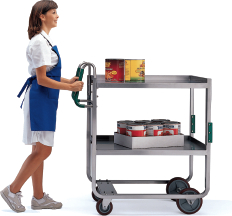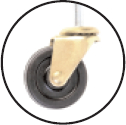

| Topic: Cart Safety | |
| Date Issued: June 1, 2004 | Date Revised: |
Every year, New Brunswick workers are injured using carts. These injuries vary in terms of the type and severity, body part involved, and the industry in which they occur.
Several factors contribute to the cart’s overall ease of handling. Some physical aspects of carts are generic, whereas others should be tailored to the individual needs of the job, work environment, and worker. Below are some tips for purchasing/modifying/assessing carts that may help reduce the risk of injury.
Whenever possible, opt to push instead of pull and use two hands.
To ensure adequate visibility for most employees pushing carts, the height of the cart being pushed should not exceed 1.4 m. If the width and length exceed 1 m and 1.3 m respectively, the cart will not manoeuvre properly in most aisles.
Ensure that the load is stable and do not overload carts.This increases the manoeuvrability of the cart and prevents objects from falling.
The cart should be loaded so that the heaviest/most frequently used objects are handled around waist height.
There are a number of mechanical aids available on the market.These options should be considered in certain situations and are dependent on factors such as the distance the cart is transported, the frequency of use, the employees’ force requirements, and the presence and grade of ramps.
Inspect floors and carts (casters) regularly. Floor inspections will help ensure that the surface is smooth, dry and free of obstructions. Caster inspections monitor wear and should ensure that casters are repaired or replaced as required.


Ensure that your casters, wheels and caster configurations are appropriate in order to decrease the amount of force required to manoeuvre the cart.Take into consideration the caster/wheel type, dimensions, material, bearings, etc.
Moving the cart at a walking pace will help ensure that it can be stopped. If it is a heavy cart,walk slower. If handling a cart on a ramp, handle the cart upgrade from the load.
Allow the cart to come to a rolling stop whenever possible and avoid hallways that are cluttered or contain obstacles.
Carts should be equipped with hand brakes if they are required to perform emergency stops, have a capacity >500 kg or are regularly handled on ramps with >2% grade.
Working posture affects how much force you can exert. Carts should be pushed in a direction parallel to the floor.Working posture is affected by the orientation, placement and dimensions of the handles along with the amount of traction between the soles of the shoes and the floor. Footwear with proper traction will encourage good posture and may reduce the risk of losing balance, slipping or falling.
Handles should extend far enough away from the cart so that the lower leg will not catch under the cart. If a cart must be pulled, the handles should extend at least 20 cm away from the cart.
Employees should be trained to follow proper work methods.
June 2004